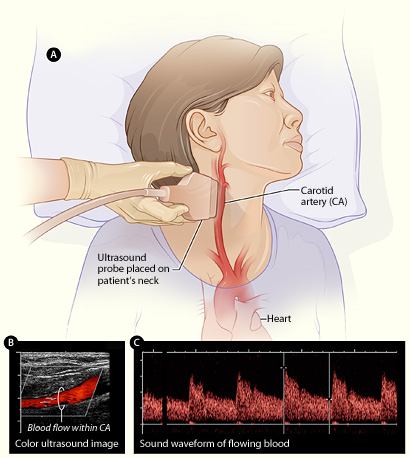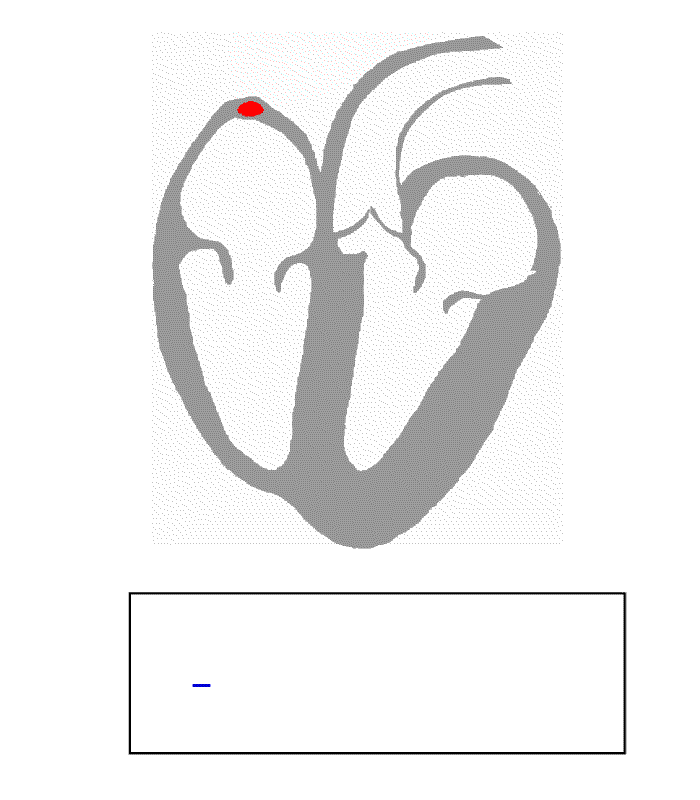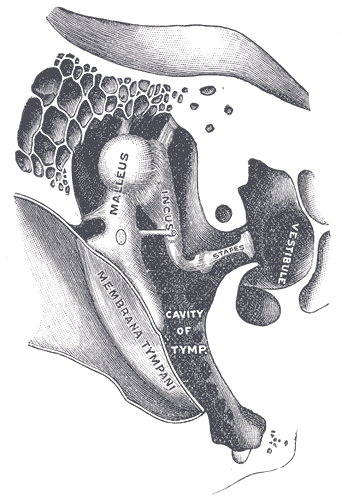|
Echogenicity
Echogenicity (sometimes as echogenecity) or echogeneity is the ability to bounce an echo, e.g. return the signal in medical ultrasound examinations. In other words, echogenicity is higher when the surface bouncing the sound echo reflects increased sound waves. Tissues that have higher echogenicity are called "hyperechoic" and are usually represented with lighter colors on images in medical ultrasonography. In contrast, tissues with lower echogenicity are called "hypoechoic" and are usually represented with darker colors. Areas that lack echogenicity are called "anechoic" and are usually displayed as completely dark. Microbubbles Echogenicity can be increased by intravenously administering gas-filled microbubble contrast agent to the systemic circulation, with the procedure being called contrast-enhanced ultrasound. This is because microbubbles have a high degree of echogenicity. When gas bubbles are caught in an ultrasonic frequency field, they compress, oscillate, and reflect ... [...More Info...] [...Related Items...] OR: [Wikipedia] [Google] [Baidu] |
Medical Ultrasonography
Medical ultrasound includes Medical diagnosis, diagnostic techniques (mainly medical imaging, imaging) using ultrasound, as well as therapeutic ultrasound, therapeutic applications of ultrasound. In diagnosis, it is used to create an image of internal body structures such as tendons, muscles, joints, blood vessels, and internal organs, to measure some characteristics (e.g., distances and velocities) or to generate an informative audible sound. The usage of ultrasound to produce visual images for medicine is called medical ultrasonography or simply sonography, or echography. The practice of examining pregnant women using ultrasound is called obstetric ultrasonography, and was an early development of clinical ultrasonography. The machine used is called an ultrasound machine, a sonograph or an echograph. The visual image formed using this technique is called an ultrasonogram, a sonogram or an echogram. Ultrasound is composed of sound waves with frequency, frequencies greater than ... [...More Info...] [...Related Items...] OR: [Wikipedia] [Google] [Baidu] |
Polycystic Ovary Syndrome
Polycystic ovary syndrome, or polycystic ovarian syndrome, (PCOS) is the most common endocrine disorder in women of reproductive age. The name is a misnomer, as not all women with this condition develop cysts on their ovaries. The name originated from the observation of cysts which form on the ovaries of some women with this condition. However, this is not a universal symptom and is not the underlying cause of the disorder. The primary characteristics of PCOS include hyperandrogenism, anovulation, insulin resistance, and neuroendocrinology, neuroendocrine disruption. Women may also experience Abnormal uterine bleeding, irregular menstrual periods, Menorrhagia, heavy periods, hirsutism, excess hair, acne, pelvic pain, infertility, difficulty getting pregnant, and patches of acanthosis nigricans, darker skin. Beyond its reproductive implications, PCOS is increasingly recognized as a multifactorial metabolic condition with significant long-term health consequences, including an ... [...More Info...] [...Related Items...] OR: [Wikipedia] [Google] [Baidu] |
Medical Physics
Medical physics deals with the application of the concepts and methods of physics to the prevention, diagnosis and treatment of human diseases with a specific goal of improving human health and well-being. Since 2008, medical physics has been included as a health profession according to International Standard Classification of Occupations, International Standard Classification of Occupation of the International Labour Organization. Although medical physics may sometimes also be referred to as ''biomedical physics'', ''medical biophysics'', ''applied physics in medicine'', ''physics applications in medical science'', ''radiological physics'' or ''hospital radio-physics'', a "medical physicist" is specifically a health professional with specialist education and training in the concepts and techniques of applying physics in medicine and competent to practice independently in one or more of the subfields of medical physics. Traditionally, medical physicists are found in the following ... [...More Info...] [...Related Items...] OR: [Wikipedia] [Google] [Baidu] |
Hearing
Hearing, or auditory perception, is the ability to perceive sounds through an organ, such as an ear, by detecting vibrations as periodic changes in the pressure of a surrounding medium. The academic field concerned with hearing is auditory science. Sound may be heard through solid, liquid, or gaseous matter. It is one of the traditional five senses. Partial or total inability to hear is called hearing loss. In humans and other vertebrates, hearing is performed primarily by the auditory system: mechanical waves, known as vibrations, are detected by the ear and transduction (physiology), transduced into nerve impulses that are perceived by the brain (primarily in the temporal lobe). Like touch, audition requires sensitivity to the movement of molecules in the world outside the organism. Both hearing and touch are types of mechanosensation. Hearing mechanism There are three main components of the human auditory system: the outer ear, the middle ear, and the inner ear. Outer ... [...More Info...] [...Related Items...] OR: [Wikipedia] [Google] [Baidu] |
Acoustics
Acoustics is a branch of physics that deals with the study of mechanical waves in gases, liquids, and solids including topics such as vibration, sound, ultrasound and infrasound. A scientist who works in the field of acoustics is an acoustician while someone working in the field of acoustics technology may be called an Acoustical engineering, acoustical engineer. The application of acoustics is present in almost all aspects of modern society with the most obvious being the audio and noise control industries. Hearing (sense), Hearing is one of the most crucial means of survival in the animal world and speech is one of the most distinctive characteristics of human development and culture. Accordingly, the science of acoustics spreads across many facets of human society—music, medicine, architecture, industrial production, warfare and more. Likewise, animal species such as songbirds and frogs use sound and hearing as a key element of mating rituals or for marking territories. Art, ... [...More Info...] [...Related Items...] OR: [Wikipedia] [Google] [Baidu] |
Echogenic Intracardiac Focus
Echogenic intracardiac focus (EIF) is a small bright spot seen in the baby's heart on an ultrasound exam. This is thought to represent mineralization, or small deposits of calcium, in the muscle of the heart. EIFs are found in about 3–5% of normal pregnancies and cause no health problems. EIFs themselves have no impact on health or heart function. Often the EIF is gone by the third trimester. If there are no problems or chromosome abnormalities, EIFs are considered normal changes, or variants. Association with birth defects Researchers have noted an association between an EIF and a chromosome problem in the baby. Types of chromosome problems that are occasionally seen include trisomy 13 (Patau syndrome) or trisomy 21 ( Down syndrome). In the case of an isolated EIF, and no other ultrasound findings, some studies show that the risk for a chromosome abnormality is approximately two times a woman's background risk. Other studies report up to a 1% risk for Down syndrome when an E ... [...More Info...] [...Related Items...] OR: [Wikipedia] [Google] [Baidu] |
Contrast-enhanced Ultrasound
Contrast-enhanced ultrasound (CEUS) is the application of ultrasound contrast medium to traditional medical sonography. Ultrasound contrast agents rely on the different ways in which sound waves are reflected from interfaces between substances. This may be the surface of a small air bubble or a more complex structure. Commercially available contrast media are gas-filled microbubbles that are administered intravenously to the systemic circulation. Microbubbles have a high degree of echogenicity (the ability of an object to reflect ultrasound waves). There is a great difference in echogenicity between the gas in the microbubbles and the soft tissue surroundings of the body. Thus, ultrasonic imaging using microbubble contrast agents enhances the ultrasound backscatter, (reflection) of the ultrasound waves, to produce a sonogram with increased contrast due to the high echogenicity difference. Contrast-enhanced ultrasound can be used to image blood perfusion in organs, measure blood ... [...More Info...] [...Related Items...] OR: [Wikipedia] [Google] [Baidu] |
Stroma (tissue)
Stroma () is the part of a tissue (biology), tissue or organ (anatomy), organ with a structural or connective role. It is made up of all the parts without specific functions of the organ - for example, connective tissue, blood vessels, ducts, etc. The other part, the parenchyma, consists of the cells that perform the function of the tissue or organ. There are multiple ways of classifying tissues: one classification scheme is based on tissue functions and another analyzes their cellular components. Stromal tissue falls into the "functional" class that contributes to the body's support and movement. Stromal cell, The cells which make up stroma tissues serve as a matrix in which the other cells are embedded. Stroma is made of various types of stromal cells. Examples of stroma include: * stroma of iris * stroma of cornea * stroma of ovary * stroma of thyroid gland * stroma of thymus * stroma of bone marrow * lymph node stromal cell *Mesenchymal stem cell, multipotent stromal cell (me ... [...More Info...] [...Related Items...] OR: [Wikipedia] [Google] [Baidu] |
Dichorionic Twins With Heart Activity At 8w5d Since Co-incubation
The chorion is the outermost fetal membrane around the embryo in mammals, birds and reptiles (amniotes). It is also present around the embryo of other animals, like insects and molluscs. Structure In humans and other therian mammals, the chorion is one of the fetal membranes that exist during pregnancy between the developing fetus and mother. The chorion and the amnion together form the amniotic sac. In humans it is formed by extraembryonic mesoderm and the two layers of trophoblast that surround the embryo and other membranes; the chorionic villi emerge from the chorion, invade the endometrium, and allow the transfer of nutrients from maternal blood to fetal blood. Layers The chorion consists of two layers: an outer formed by the trophoblast, and an inner formed by the extra-embryonic mesoderm. The trophoblast is made up of an internal layer of cubical or prismatic cells, the cytotrophoblast or layer of Langhans, and an external multinucleated layer, the syncytiotrophoblast ... [...More Info...] [...Related Items...] OR: [Wikipedia] [Google] [Baidu] |







